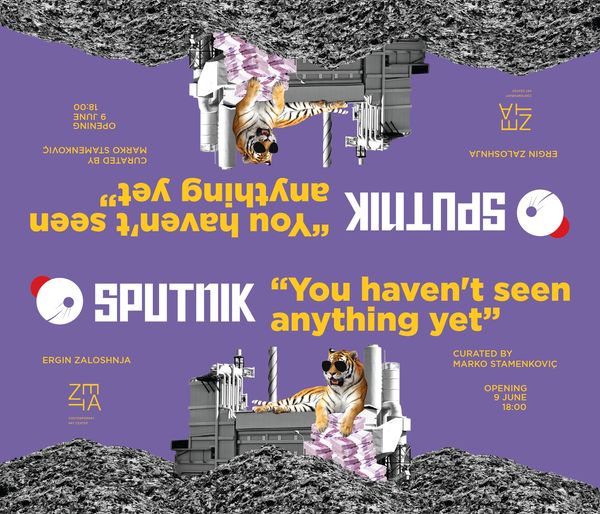You Haven’t Seen Anything Yet
A Solo Exhibition by Ergin Zaloshnja
Curated by Marko Stamenkovic
June 9 – 28, 2023
Opening: Friday, June 9, 6PM
On the occasion of the tenth anniversary of SPUTNIK, an imaginary fanzine initiated by Ergin Zaloshnja (1979, Tirana) as a periodical, single-page publication and a public, street art project under the same name, ZETA Contemporary Art Center is delighted to announce the opening of his solo exhibition YOU HAVEN’T SEEN ANYTHING YET, on view throughout June 2023.
SPUTNIK is a visual counter-propaganda chronicle offering many and varied perspectives onto Albanian history over the last ten years (2013-2023). This is a period unlike any other before: beautiful, happy and optimistic (especially for those who have not yet emigrated abroad in search of work, decent wages and a better standard of living), full of progress and economic development, of unprecedented modernization and urbanization, of social justice and cultural growth. This progress is being made on the model of the best of all possible worlds (the Western world) and on the trail of its vision of democracy – the most powerful of all neoliberal mantras to be believed, without any objection or alternative.
This is also the period of Albanian 21st-century “Renaissance”. It corresponds with the ascent of the (governing) Socialist Party and its leaders in a country unlike any other: the country whose main political and cultural protagonist – besides playing the role of a Prime Minister (since 2013) – also happens to be Ergin Zaloshnja’s colleague. SPUTNIK would not have existed, perhaps, without this God-given painter standing firmly above one nation – a heavenly nation ‘re-born’ under the spell of Edi Rama’s aesthetic visions and their embodiment on Earth – in Albania’s “Garden of earthly delights” and its darker backstage (which you may have not yet seen… but you may want to see it now!).
Colorful figures, gestures, buildings, situations, events, messages and media truths coexist in this garden: they are indelible parts of a great puzzle, of a Grand Vision for Albanian Future shared by the Prime Minister and his entourage ranging from national institutions to local municipalities and corporations (domestic and foreign alike), all working towards one single goal – the benefit of the People. But there is more to be seen!
Ergin Zaloshnja does not accept the proposed grandeur of his country’s contemporary (visual) ideology as a given; rather, he questions it from his disobedient position of a citizen, but also from the position of Prime Minister’s colleague – a visual artist and image-maker – in order to unveil this ideology’s underbelly through images that matter (or may matter even more in the future to come). Zaloshnja brings together counter-narratives proper to selected iconic moments of Albanian “Renaissance”, while turning them into their twisted mirror-reflections through his counter-propaganda magazine and its 20 editions that have appeared so far. Both realistic and surrealistic, tragical and comical, they depict the scenes of real life that are neither bright nor optimistic, but sarcastic and reimagined in a dystopian, decadent, fascist-looking scenario merging the past, the present, and the future. In the conceptual footsteps of the late 15th and early 16th century triptych “The Garden of Earthly Delights”, Zaloshnja shares Hieronymus Bosch’s visions as both artists aim at the same target: to critically address the mainstream visual ideology of their own times and to re-paint its self-fulfilling, “prophetic”, and utopian image by alternative narratives under its surface.
The local reality is here observed from a much wider perspective, through its intersections with and dependencies upon the logic and circuits of global capitalism and its major exponents: a number of “world-making and world-shaking” supranational, governmental and non-governmental organizations (such as The Club of Rome, Trilateral Commission, Council of Foreign Relations, World Economic Forum, International Monetary Fund, World Bank, United Nations, World Health Organization, NATO, European Union, World Trade Organization and UNICEF). Their respective logotypes adorn a series of virtual red flags, created by Zaloshnja for this occasion in the form of a mute single-channel video piece accompanying his SPUTNIK, to bring attention to the causal relationships between the glorious brains of global capital around the world and the traces, or excrements, of its even more glorious body parts back home, in the gorges of the Balkans.
Cataloguing some of the main local issues of public concern over the last decade (including corruption and crime) – and encapsulating them from a global perspective – the exhibition features a heavily mediatized world “turned upside down”: through what may look like a cynical yet intelligently summarized iconographical confrontation of political and economic injustice, on the one hand, and its visual counter-propositions of ethical urgency, on the other. But this is only the main side of the show – you haven’t seen anything yet!
Marko Stamenkovic
